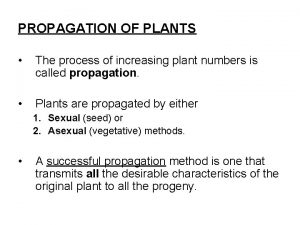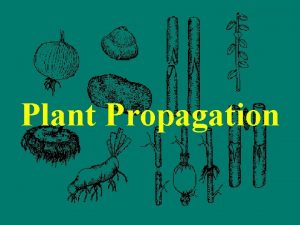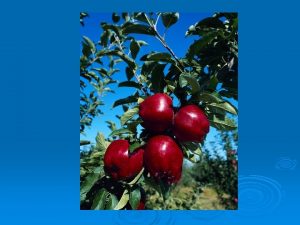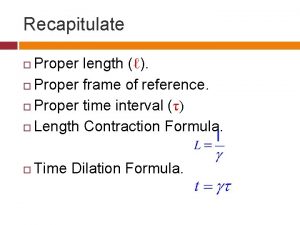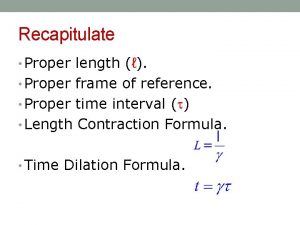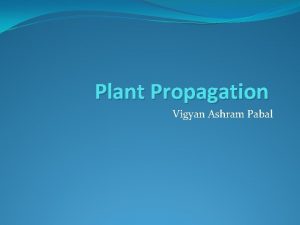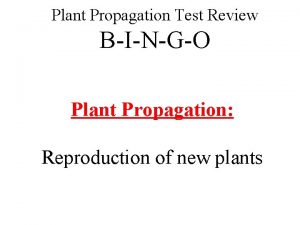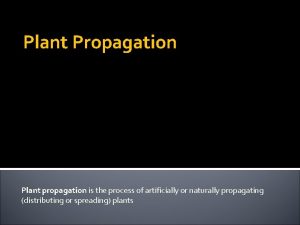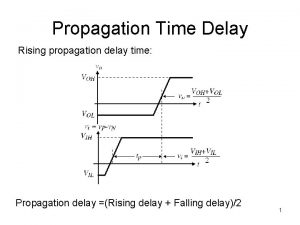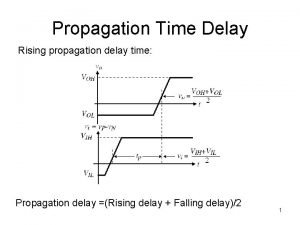Plant Propagation An introduction to the proper propagation














- Slides: 14

Plant Propagation An introduction to the proper, propagation of plants!

What Is Asexual Reproduction? n n Asexual reproduction in plants involves the reproduction of new plants using only the vegetative parts of the parent plant Also called Plant Propagation Courtesy of Interstate Publishers

Why Should We Propagate? n n n What if the plant is difficult to germinate or doesn’t create a viable seed? Think about an orchid! What if the plant that you want more of is perfect? You want it to be true to seed.

This form of reproduction produces plants that are identical to the parent plant Courtesy of Interstate Publishers

Asexual propagation may be faster than propagation by seed n n Germination and growth of seedlings is often slow compared to propagation by cuttings It may also be more economical to produce plants asexually and in many cases it is easier So let’s learn more about propagation!!!!! Courtesy of Interstate Publishers

n Leaf – stem cutting n Division, Separation, and Layering n Grafting and Budding n Tissue Culture A. D. B. C.

All of these put together are great ways to propagate just about any plant!!!! Layering etc. Tissue Culture Leaf Cutting Grafting

Review of Plant Parts stipule bud stem midrib node axil internode blade petiole node

Leaf and Leaf-Bud Cuttings A leaf cutting is a piece of a leaf blade, or a leaf blade with a petiole attached A leaf-bud cutting consists of a leaf blade, the petiole, and a short piece of stem with an attached bud

Leaf Cuttings n Healthy leaves that have just reached maturity should be used for leaf cuttings n Some plants may be propagated using only the leaf blade or a section of the leaf The leaf is cut from the parent plant and the cut edge placed on top of the rooting medium or inserted into the medium n New plants develop along the edge of the leaf. n

Leaf Cuttings Continued n Some plants require that both the leaf blade and petiole be removed from the parent plant n n These cuttings should be placed deep enough in the medium to keep the cutting upright Moisture is very important for the growth of the cutting n The cuttings cannot absorb water quickly so they must be kept moist n However, too much water will cause the cuttings of most plants to rot

Processing the Cutting n What you should do with the cutting before planting to ensure less water loss? q q Process it immediately If not possible put the cut into water and bag it up. Put it into direct sun. Remove some of the leaves. About 1/2 to 2/3 of the leaves. If large leaves are left, cut them in half. Place in the rooting medium, put pot in a bag (keep the bag off of cutting), and put the processed cutting in the greenhouse. Keep it out of direct light.

Rooting Medium and Root Formation n n Rooting Medium- The substance that allows maximum root growth. Usually consisting of different parts water absorbers and aerators. A good rooting medium should consist of 50% vermiculite and 50% perlite. This will hold sufficient air and water for maximum root growth. To encourage root formation, apply a rooting hormone to the edge of the cutting. Keep your cuttings at temperatures between 65 and 75 degrees Fahrenheit.

Now let’s get goin’ into the greenhouse and practice some cuttings in our groups!!!!!
 Scope of plant breeding
Scope of plant breeding Taichum
Taichum Plant introduction in plant breeding
Plant introduction in plant breeding Ours was the marsh country
Ours was the marsh country Simple layering examples
Simple layering examples Advantages of plant propagation
Advantages of plant propagation Specialized structure
Specialized structure Tronsmo plant pathology and plant diseases download
Tronsmo plant pathology and plant diseases download Tronsmo plant pathology and plant diseases download
Tronsmo plant pathology and plant diseases download Albugo eye
Albugo eye Hát kết hợp bộ gõ cơ thể
Hát kết hợp bộ gõ cơ thể Frameset trong html5
Frameset trong html5 Bổ thể
Bổ thể Tỉ lệ cơ thể trẻ em
Tỉ lệ cơ thể trẻ em Chó sói
Chó sói





